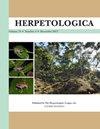A New Species of Hemidactylus Goldfuss, 1820 (Reptilia: Gekkonidae) from Sri Lanka with Redescription of H. hunae Deraniyagala, 1937
IF 1.1
3区 生物学
Q2 ZOOLOGY
引用次数: 6
Abstract
Abstract We describe a large gecko of genus Hemidactylus from the southern face peneplain foothills of the Central Highlands of Sri Lanka. It closely resembles Hemidactylus hunae Deraniyagala 1937 but is distinguished by adult males reaching 121.2 mm snout–vent length; presence of 11 or 12 supralabials at the midorbit position; dorsal scalation of homogeneous granules intermixed with large, conical, carinate tubercles that form 12–14 irregularly arranged longitudinal rows at midbody; dorsal furrow distinct with a narrow space between medial parasagittal rows; 3 or 4 pairs of postmentals; no spine-like tubercles on nape; ventrals in 36–39 rows at midbody; 21–24 femoral pores on each side separated medially by 5–7 nonpored enlarged scales; scales on posterior thigh granular, not enlarged; lamellae divided, 12 or 13 below the fourth toe; tail segmented with whorls of lateral tubercles, with each whorl consisting of 6 enlarged, conical, carinate tubercles; median row enlarged and broad; single postcloacal tubercle (spur) on each side; and body dorsum with a series of black edged bright saddles from occiput to tail tip. Additionally, we provide a redescription for H. hunae based on its adult female holotype.斯里兰卡金纹半指虫一新种,1820(爬行纲:革螨科),并对H.hunae Deraniyagala进行重新描述,1937
摘要我们描述了一种来自斯里兰卡中部高地南部准平原山麓的半指壁虎属大型壁虎。它与1937年的Deraniyagala半指龙非常相似,但其区别在于成年雄性达到121.2毫米的吻部-喷口长度;在眶中位置存在11或12个唇上;均匀颗粒的背侧分级与大的圆锥形隆起结节混合,在中体形成12-14个不规则排列的纵向行;背侧沟明显,内侧副矢状行之间有狭窄的间隔;3或4对后置;颈背无脊状结节;腹肌在腹肌中部36~39排;每侧21–24个股骨孔,中间由5–7个非红色扩大鳞片分隔;鳞片在大腿后部颗粒状,不扩大;片层分开,在第四趾部下方12或13;尾分节,具侧结节的轮生,每轮生由6个扩大的,圆锥形,隆起的结节组成;中间行扩大和宽阔;在每侧上的单个槽后结节(刺);身体背侧有一系列从枕骨到尾尖的黑边亮鞍。此外,我们根据其成年雌性的正模,对胡奈进行了重新描述。
本文章由计算机程序翻译,如有差异,请以英文原文为准。
求助全文
约1分钟内获得全文
求助全文
来源期刊

Herpetologica
生物-动物学
CiteScore
4.60
自引率
0.00%
发文量
27
审稿时长
>12 weeks
期刊介绍:
Established in 1936, Herpetologica is a quarterly peer-reviewed journal serving herpetologists, biologists, ecologists, conservationists, researchers and the scientific community. The journal contains original research papers and essays about the biology of reptiles and amphibians, and covers many relevant topics including: behavior, conservation, ecology, genetics, morphology, physiology and taxonomy.
 求助内容:
求助内容: 应助结果提醒方式:
应助结果提醒方式:


